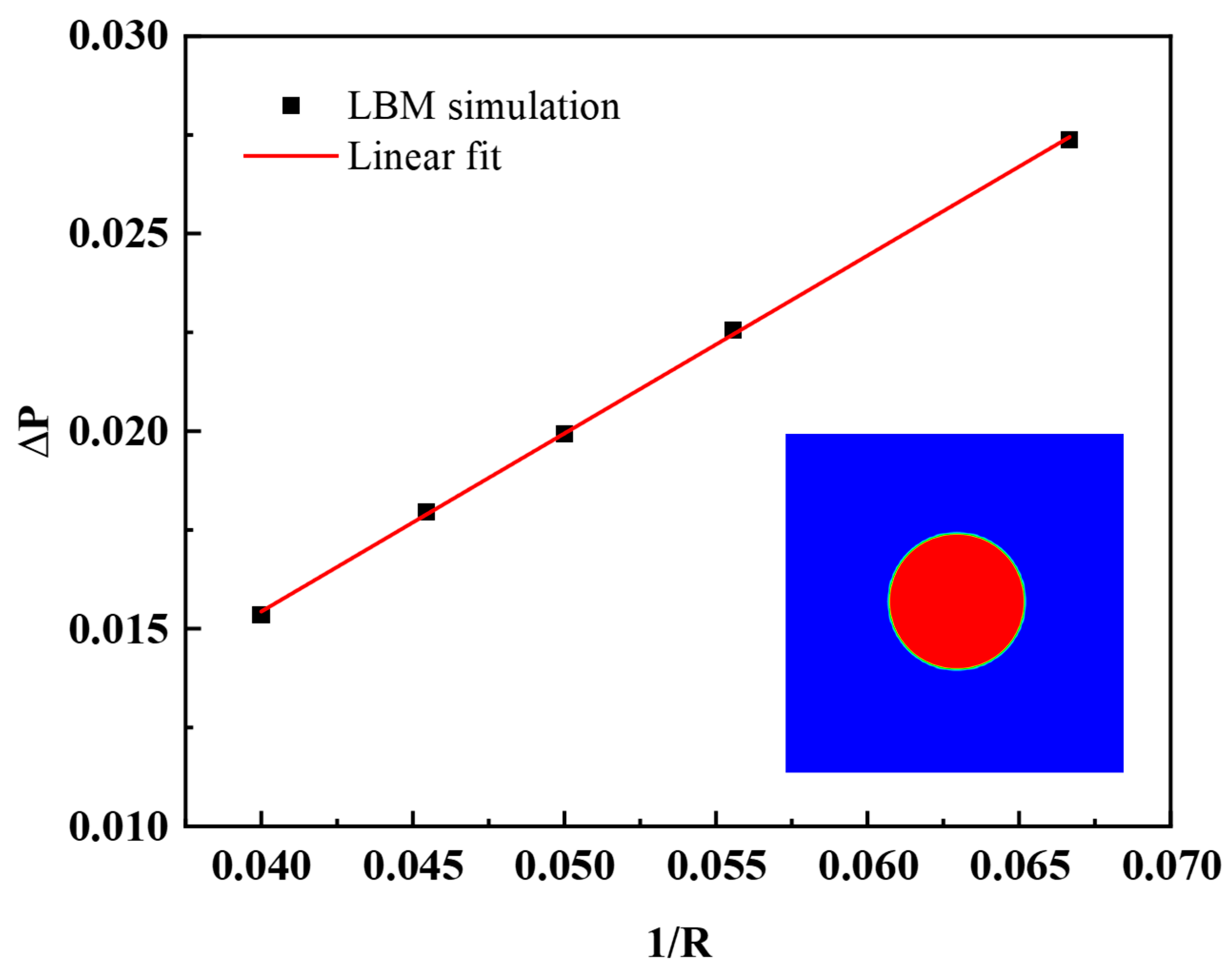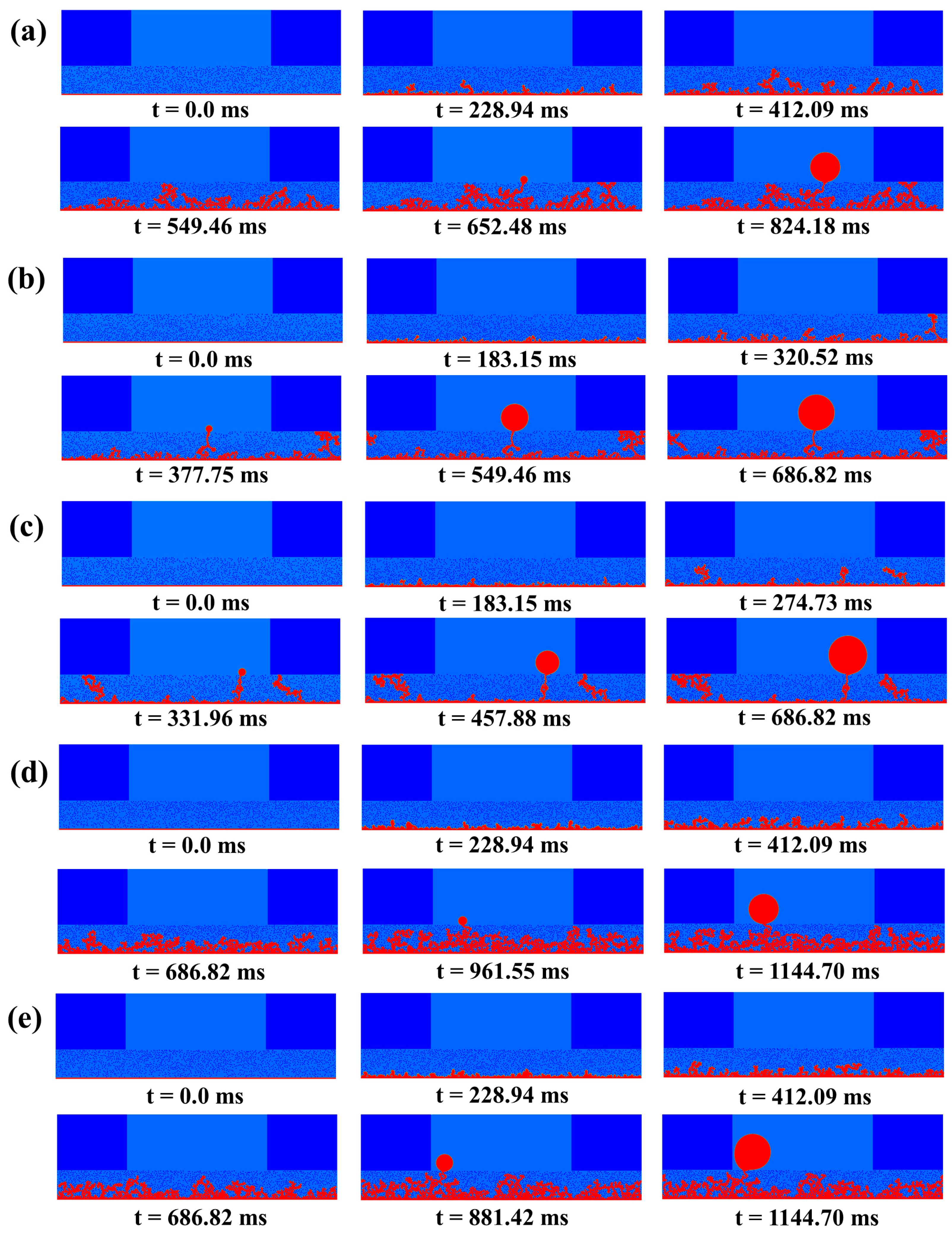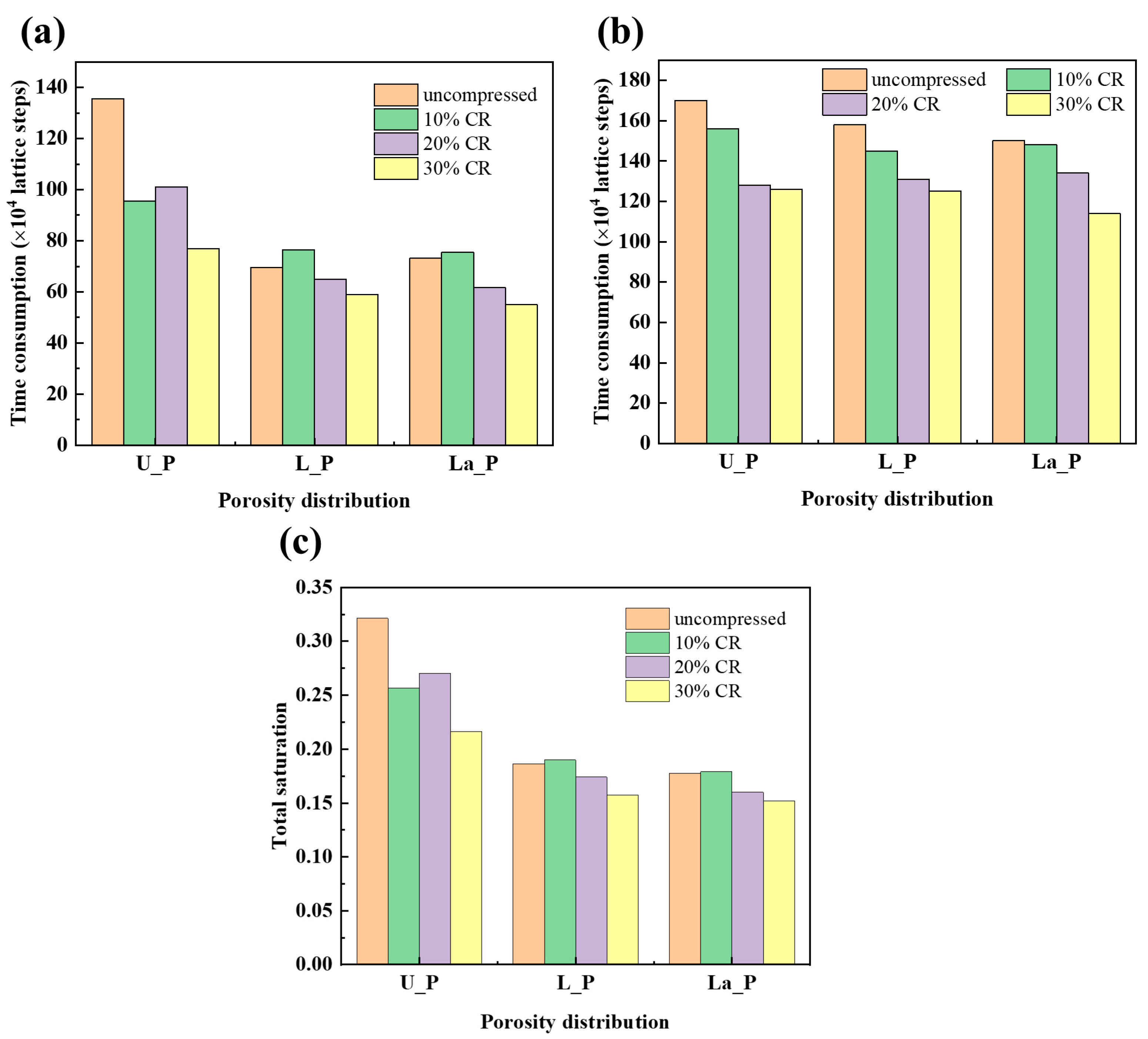Liquid Water Characteristics in the Compressed Gradient Porosity Gas Diffusion Layer of Proton Exchange Membrane Fuel Cells Using the Lattice Boltzmann Method
Abstract
:1. Introduction
2. Methods
2.1. LBM Model
2.2. Computational Domain and Boundary Condition
- According to previous research [54], compression affects only the pore volume of the GDL, while the volume of the GDL fiber remains unchanged. As a result, the correlation between compression ratio and porosity is derived as follows:
2.3. Numerical Procedure
3. Results and Discussion
3.1. Model Validation
3.1.1. Laplace Test
3.1.2. Static Contact Angle Test
3.2. Effects of Porosity Distribution
3.2.1. Liquid Water Dynamic Behaviors
3.2.2. Liquid Saturation and Distribution
3.3. Effect of Compression
4. Conclusions
- The gradient structure characterized by an increase in porosity along the thickness direction results in a considerable reduction in both the breakthrough time of liquid water and the total water saturation within the GDL; compared to uniform distribution, the values are reduced by 47.54% and 42.02% for the linear structure, and 44.08% and 44.66% for layered structure, respectively. Moreover, although the overall water saturation of the layered structure is lower than that of the linear structure, it has higher water saturation at the entrance and longer breakthrough time; consequently, at the uncompressed condition, the linear structure instead has the best water management ability improvement;
- At high CR, the positive gradient structure can achieve dramatic liquid water transport improvements, especially under the ribs. Since the porosity under the rib decreases after compression, the water saturation under the rib is effectively reduced among all porosity distribution structures. But compared to the uniform structure, as the capillary pressure gradient still exists under the rib with the positive gradient, the water still penetrates the GDL under 20% CR, which is not conducive to water management, resulting in a higher CR for the positive gradient structure to successfully promote the water distribution under the rib. And under the flow channel, unlike the uniform distribution structure, the positive gradient structure has the highest breakthrough time and overall water saturation at 10% CR instead of the uncompressed case, while the corresponding values all decrease as the CR continues to increase. Consequently, for the positive gradient structure, better water management can be achieved at a relatively high CR;
- As the CR increases, the linear positive gradient porosity structure provides better water management at the entrance of the GDL. When a GDL of such distribution is compressed, the water saturation under the flow channel increases first and then decreases, and because the capillary pressure gradient exists along the entire thickness direction, liquid water is prone to invade along the TP direction, and thus the water saturation at the entrance of the GDL is relatively low. Accordingly, despite the lower breakthrough time and total water saturation, layered positive porosity distribution is less efficient in improving water discharge under the channel after compression due to the fact that liquid water clusters prefer to gather in the bottom of it with the increase of CR.
Author Contributions
Funding
Data Availability Statement
Acknowledgments
Conflicts of Interest
References
- Haider, R.; Wen, Y.; Ma, Z.F.; Wilkinson, D.P.; Zhang, L.; Yuan, X.; Song, S.; Zhang, J. High temperature proton exchange membrane fuel cells: Progress in advanced materials and key technologies. Chem. Soc. Rev. 2021, 50, 1138–1187. [Google Scholar] [CrossRef]
- Tang, X.; Zhang, Y.; Xu, S. Temperature sensitivity characteristics of PEM fuel cell and output performance improvement based on optimal active temperature control. Int. J. Heat Mass Transf. 2023, 206, 123966. [Google Scholar] [CrossRef]
- Olabi, A.G.; Wilberforce, T.; Alanazi, A.; Vichare, P.; Sayed, E.T.; Maghrabie, H.M.; Elsaid, K.; Abdelkareem, M.A. Novel Trends in Proton Exchange Membrane Fuel Cells. Energies 2022, 15, 4949. [Google Scholar] [CrossRef]
- Tang, X.; Zhang, Y.; Xu, S. Experimental study of PEM fuel cell temperature characteristic and corresponding automated optimal temperature calibration model. Energy 2023, 283, 128456. [Google Scholar] [CrossRef]
- Ozden, A.; Shahgaldi, S.; Li, X.; Hamdullahpur, F. A review of gas diffusion layers for proton exchange membrane fuel cells—With a focus on characteristics, characterization techniques, materials and designs. Prog. Energy Combust. Sci. 2019, 74, 50–102. [Google Scholar] [CrossRef]
- Wang, Y.; Ruiz Diaz, D.F.; Chen, K.S.; Wang, Z.; Adroher, X.C. Materials, technological status, and fundamentals of PEM fuel cells—A review. Mater. Today 2020, 32, 178–203. [Google Scholar] [CrossRef]
- Chen, Q.; Niu, Z.; Li, H.; Jiao, K.; Wang, Y. Recent progress of gas diffusion layer in proton exchange membrane fuel cell: Two–phase flow and material properties. Int. J. Hydrog. Energy 2021, 46, 8640–8671. [Google Scholar] [CrossRef]
- Jiao, K.; Xuan, J.; Du, Q.; Bao, Z.; Xie, B.; Wang, B.; Zhao, Y.; Fan, L.; Wang, H.; Hou, Z.; et al. Designing the next generation of proton–exchange membrane fuel cells. Nature 2021, 595, 361–369. [Google Scholar] [CrossRef]
- Wang, G.; Yu, Y.; Liu, H.; Gong, C.; Wen, S.; Wang, X.; Tu, Z. Progress on design and development of polymer electrolyte membrane fuel cell systems for vehicle applications: A review. Fuel Process. Technol. 2018, 179, 203–228. [Google Scholar] [CrossRef]
- Pourrahmani, H.; Van Herle, J. Water management of the proton exchange membrane fuel cells: Optimizing the effect of microstructural properties on the gas diffusion layer liquid removal. Energy 2022, 256, 124712. [Google Scholar] [CrossRef]
- Ijaodola, O.S.; El–Hassan, Z.; Ogungbemi, E.; Khatib, F.N.; Wilberforce, T.; Thompson, J.; Olabi, A.G. Energy efficiency improvements by investigating the water flooding management on proton exchange membrane fuel cell (PEMFC). Energy 2019, 179, 246–267. [Google Scholar] [CrossRef]
- Markotter, H.; Manke, I.; Kruger, P.; Arlt, T.; Haussmann, J.; Klages, M.; Riesemeier, H.; Hartnig, C.; Scholta, J.; Banhart, J. Investigation of 3D water transport paths in gas diffusion layers by combined in–situ synchrotron X–ray radiography and tomography. Electrochem. Commun. 2011, 13, 1001–1004. [Google Scholar] [CrossRef]
- Deevanhxay, P.; Sasabe, T.; Tsushima, S.; Hirai, S. Observation of dynamic liquid water transport in the microporous layer and gas diffusion layer of an operating PEM fuel cell by high–resolution soft X–ray radiography. J. Power Sources 2013, 230, 38–43. [Google Scholar] [CrossRef]
- Flückiger, R.; Marone, F.; Stampanoni, M.; Wokaun, A.; Büchi, F.N. Investigation of liquid water in gas diffusion layers of polymer electrolyte fuel cells using X–ray tomographic microscopy. Electrochim. Acta 2011, 56, 2254–2262. [Google Scholar] [CrossRef]
- Ko, D.; Kwak, H.J.; Kim, M.H. The effects of water accumulation at the interface between gas diffusion layer and gas supplying channel on the water distribution in polymer electrolyte membrane fuel cells. Int. J. Hydrog. Energy 2019, 44, 24947–24953. [Google Scholar] [CrossRef]
- Kulkarni, N.; Cho, J.I.S.; Rasha, L.; Owen, R.E.; Wu, Y.; Ziesche, R.; Hack, J.; Neville, T.; Whiteley, M.; Kardjilov, N.; et al. Effect of cell compression on the water dynamics of a polymer electrolyte fuel cell using in–plane and through–plane in–operando neutron radiography. J. Power Sources 2019, 439, 227074. [Google Scholar] [CrossRef]
- Cooper, N.J.; Santamaria, A.D.; Becton, M.K.; Park, J.W. Neutron radiography measurements of in–situ PEMFC liquid water saturation in 2D & 3D morphology gas diffusion layers. Int. J. Hydrog. Energy 2017, 42, 16269–16278. [Google Scholar] [CrossRef]
- Zapardiel, D.; García–Salaberri, P.A. Modeling the interplay between water capillary transport and species diffusion in gas diffusion layers of proton exchange fuel cells using a hybrid computational fluid dynamics formulation. J. Power Sources 2021, 520, 230735. [Google Scholar] [CrossRef]
- Nanadegani, F.S.; Lay, E.N.; Sunden, B. Computational analysis of the impact of a micro porous layer (MPL) on the characteristics of a high temperature PEMFC. Electrochim. Acta 2020, 333, 135552. [Google Scholar] [CrossRef]
- Chen, L.; He, A.; Zhao, J.; Kang, Q.; Li, Z. –Y.; Carmeliet, J.; Shikazono, N.; Tao, W.–Q. Pore–scale modeling of complex transport phenomena in porous media. Prog. Energy Combust. Sci. 2022, 88, 100968. [Google Scholar] [CrossRef]
- Shahraeeni, M.; Hoorfar, M. Pore–network modeling of liquid water flow in gas diffusion layers of proton exchange membrane fuel cells. Int. J. Hydrog. Energy 2014, 39, 10697–10709. [Google Scholar] [CrossRef]
- Carrere, P.; Prat, M. Liquid water in cathode gas diffusion layers of PEM fuel cells: Identification of various pore filling regimes from pore network simulations. Int. J. Heat Mass Transf. 2019, 129, 1043–1056. [Google Scholar] [CrossRef]
- Niu, Z.; Wang, Y.; Jiao, K.; Wu, J. Two–Phase Flow Dynamics in the Gas Diffusion Layer of Proton Exchange Membrane Fuel Cells: Volume of Fluid Modeling and Comparison with Experiment. J. Electrochem. Soc. 2018, 165, F613–F620. [Google Scholar] [CrossRef]
- Zhou, X.; Wu, L.; Niu, Z.; Bao, Z.; Sun, X.; Liu, Z.; Li, Y.; Jiao, K.; Liu, Z.; Du, Q. Effects of surface wettability on two–phase flow in the compressed gas diffusion layer microstructures. Int. J. Heat Mass Transf. 2020, 151, 119370. [Google Scholar] [CrossRef]
- Zhou, X.; Niu, Z.; Bao, Z.; Wang, J.; Liu, Z.; Yin, Y.; Du, Q.; Jiao, K. Two–phase flow in compressed gas diffusion layer: Finite element and volume of fluid modeling. J. Power Sources 2019, 437, 226933. [Google Scholar] [CrossRef]
- Yang, M.; Yan, S.; Du, A.; Liu, J.; Xu, S. Effect of micro–cracks on the in–plane electronic conductivity of proton exchange membrane fuel cell catalyst layers based on lattice Boltzmann method. Int. J. Hydrog. Energy 2022, 47, 39961–39972. [Google Scholar] [CrossRef]
- Molaeimanesh, G.R.; Googarchin, H.S.; Moqaddam, A.Q. Lattice Boltzmann simulation of proton exchange membrane fuel cells—A review on opportunities and challenges. Int. J. Hydrog. Energy 2016, 41, 22221–22245. [Google Scholar] [CrossRef]
- D’Orazio, A.; Karimipour, A.; Ranjbarzadeh, R. Lattice Boltzmann Modelling of Fluid Flow through Porous Media: A Comparison between Pore–Structure and Representative Elementary Volume Methods. Energies 2023, 16, 5354. [Google Scholar] [CrossRef]
- Kim, K.N.; Kang, J.H.; Lee, S.G.; Nam, J.H.; Kim, C.-J. Lattice Boltzmann simulation of liquid water transport in microporous and gas diffusion layers of polymer electrolyte membrane fuel cells. J. Power Sources 2015, 278, 703–717. [Google Scholar] [CrossRef]
- Jinuntuya, F.; Whiteley, M.; Chen, R.; Fly, A. The effects of gas diffusion layers structure on water transportation using X–ray computed tomography based Lattice Boltzmann method. J. Power Sources 2018, 378, 53–65. [Google Scholar] [CrossRef]
- Deng, H.; Hou, Y.; Jiao, K. Lattice Boltzmann simulation of liquid water transport inside and at interface of gas diffusion and micro–porous layers of PEM fuel cells. Int. J. Heat Mass Transf. 2019, 140, 1074–1090. [Google Scholar] [CrossRef]
- Sepe, M.; Satjaritanun, P.; Hirano, S.; Zenyuk, I.V.; Tippayawong, N.; Shimpalee, S. Investigating Liquid Water Transport in Different Pore Structure of Gas Diffusion Layers for PEMFC Using Lattice Boltzmann Method. J. Electrochem. Soc. 2020, 167, 104516. [Google Scholar] [CrossRef]
- Zenyuk, I.V.; Parkinson, D.Y.; Connolly, L.G.; Weber, A.Z. Gas–diffusion–layer structural properties under compression via X–ray tomography. J. Power Sources 2016, 328, 364–376. [Google Scholar] [CrossRef]
- Wu, Y.; Cho, J.I.S.; Lu, X.; Rasha, L.; Neville, T.P.; Millichamp, J.; Ziesche, R.; Kardjilov, N.; Markötter, H.; Shearing, P.; et al. Effect of compression on the water management of polymer electrolyte fuel cells: An in–operando neutron radiography study. J. Power Sources 2019, 412, 597–605. [Google Scholar] [CrossRef]
- Bazylak, A.; Sinton, D.; Liu, Z.S.; Djilali, N. Effect of compression on liquid water transport and microstructure of PEMFC gas diffusion layers. J. Power Sources 2007, 163, 784–792. [Google Scholar] [CrossRef]
- Zenyuk, I.V.; Parkinson, D.Y.; Hwang, G.; Weber, A.Z. Probing water distribution in compressed fuel–cell gas–diffusion layers using X–ray computed tomography. Electrochem. Commun. 2015, 53, 24–28. [Google Scholar] [CrossRef]
- Jeon, D.H.; Kim, H. Effect of compression on water transport in gas diffusion layer of polymer electrolyte membrane fuel cell using lattice Boltzmann method. J. Power Sources 2015, 294, 393–405. [Google Scholar] [CrossRef]
- Moslemi, M.; Javaherdeh, K.; Ashorynejad, H.R. Effect of compression of microporous and gas diffusion layers on liquid water transport of PEMFC with interdigitated flow field by Lattice Boltzmann method. Colloids Surf. A Physicochem. Eng. Asp. 2022, 642, 128623. [Google Scholar] [CrossRef]
- Ira, Y.; Bakhshan, Y.; Khorshidimalahmadi, J. Effect of wettability heterogeneity and compression on liquid water transport in gas diffusion layer coated with microporous layer of PEMFC. Int. J. Hydrog. Energy 2021, 46, 17397–17413. [Google Scholar] [CrossRef]
- Shangguan, X.; Li, Y.; Qin, Y.; Cao, S.; Zhang, J.; Yin, Y. Effect of the porosity distribution on the liquid water transport in the gas diffusion layer of PEMFC. Electrochim. Acta 2021, 371, 137814. [Google Scholar] [CrossRef]
- Oh, H.; Park, J.; Min, K.; Lee, E.; Jyoung, J.-Y. Effects of pore size gradient in the substrate of a gas diffusion layer on the performance of a proton exchange membrane fuel cell. Appl. Energy 2015, 149, 186–193. [Google Scholar] [CrossRef]
- Park, J.; Oh, H.; Lee, Y.I.; Min, K.; Lee, E.; Jyoung, J.-Y. Effect of the pore size variation in the substrate of the gas diffusion layer on water management and fuel cell performance. Appl. Energy 2016, 171, 200–212. [Google Scholar] [CrossRef]
- Ko, D.; Doh, S.; Park, H.S.; Kim, M.H. The effect of through plane pore gradient GDL on the water distribution of PEMFC. Int. J. Hydrog. Energy 2018, 43, 2369–2380. [Google Scholar] [CrossRef]
- Zhang, Y.; Verma, A.; Pitchumani, R. Optimum design of polymer electrolyte membrane fuel cell with graded porosity gas diffusion layer. Int. J. Hydrog. Energy 2016, 41, 8412–8426. [Google Scholar] [CrossRef]
- Kong, I.M.; Jung, A.; Kim, Y.S.; Kim, M.S. Numerical investigation on double gas diffusion backing layer functionalized on water removal in a proton exchange membrane fuel cell. Energy 2017, 120, 478–487. [Google Scholar] [CrossRef]
- Kanchan, B.K.; Randive, P.; Pati, S. Numerical investigation of multi–layered porosity in the gas diffusion layer on the performance of a PEM fuel cell. Int. J. Hydrog. Energy 2020, 45, 21836–21847. [Google Scholar] [CrossRef]
- Wang, H.; Yang, G.; Shen, Q.; Li, S.; Su, F.; Jiang, Z.; Liao, J.; Zhang, G.; Sun, J. Effects of Compression and Porosity Gradients on Two–Phase Behavior in Gas Diffusion Layer of Proton Exchange Membrane Fuel Cells. Membranes 2023, 13, 303. [Google Scholar] [CrossRef]
- Yang, M.; Jiang, Y.; Liu, J.; Xu, S.; Du, A. Lattice Boltzmann method modeling and experimental study on liquid water characteristics in the gas diffusion layer of proton exchange membrane fuel cells. Int. J. Hydrog. Energy 2022, 47, 10366–10380. [Google Scholar] [CrossRef]
- Habiballahi, M.; Hassanzadeh, H.; Rahnama, M.; Ali Mirbozorgi, S.; Jahanshahi Javaran, E. Effect of porosity gradient in cathode gas diffusion layer of polymer electrolyte membrane fuel cells on the liquid water transport using lattice Boltzmann method. Proc. Inst. Mech. Eng. Part A J. Power Energy 2020, 235, 546–562. [Google Scholar] [CrossRef]
- Guo, L.; Chen, L.; Zhang, R.; Peng, M.; Tao, W.-Q. Pore–scale simulation of two–phase flow and oxygen reactive transport in gas diffusion layer of proton exchange membrane fuel cells: Effects of nonuniform wettability and porosity. Energy 2022, 253, 124101. [Google Scholar] [CrossRef]
- Hottinen, T.; Himanen, O.; Karvonen, S.; Nitta, I. Inhomogeneous compression of PEMFC gas diffusion layer. J. Power Sources 2007, 171, 113–121. [Google Scholar] [CrossRef]
- Carral, C.; Mélé, P. A numerical analysis of PEMFC stack assembly through a 3D finite element model. Int. J. Hydrog. Energy 2014, 39, 4516–4530. [Google Scholar] [CrossRef]
- Kleemann, J.; Finsterwalder, F.; Tillmetz, W. Characterisation of mechanical behaviour and coupled electrical properties of polymer electrolyte membrane fuel cell gas diffusion layers. J. Power Sources 2009, 190, 92–102. [Google Scholar] [CrossRef]
- Yoshimune, W.; Kato, S.; Yamaguchi, S. Multi–scale pore morphologies of a compressed gas diffusion layer for polymer electrolyte fuel cells. Int. J. Heat Mass Transf. 2020, 152, 119537. [Google Scholar] [CrossRef]
- Hao, L.; Cheng, P. Lattice Boltzmann simulations of water transport in gas diffusion layer of a polymer electrolyte membrane fuel cell. J. Power Sources 2010, 195, 3870–3881. [Google Scholar] [CrossRef]
- Sim, J.; Kang, M.; Min, K. Effects of basic gas diffusion layer components on PEMFC performance with capillary pressure gradient. Int. J. Hydrog. Energy 2021, 46, 27731–27748. [Google Scholar] [CrossRef]
- Satjaritanun, P.; Hirano, S.; Shum, A.D.; Zenyuk, I.V.; Weber, A.Z.; Weidner, J.W.; Shimpalee, S. Fundamental Understanding of Water Movement in Gas Diffusion Layer under Different Arrangements Using Combination of Direct Modeling and Experimental Visualization. J. Electrochem. Soc. 2018, 165, F1115–F1126. [Google Scholar] [CrossRef]
- Senthil Velan, V.; Velayutham, G.; Rajalakshmi, N.; Dhathathreyan, K.S. Influence of compressive stress on the pore structure of carbon cloth based gas diffusion layer investigated by capillary flow porometry. Int. J. Hydrog. Energy 2014, 39, 1752–1759. [Google Scholar] [CrossRef]
- Mahmoudi, A.H.; Ramiar, A.; Esmaili, Q. Effect of inhomogeneous compression of gas diffusion layer on the performance of PEMFC with interdigitated flow field. Energy Convers. Manag. 2016, 110, 78–89. [Google Scholar] [CrossRef]
- Zhou, X.; Niu, Z.; Li, Y.; Sun, X.; Du, Q.; Xuan, J.; Jiao, K. Investigation of two–phase flow in the compressed gas diffusion layer microstructures. Int. J. Hydrog. Energy 2019, 44, 26498–26516. [Google Scholar] [CrossRef]









Disclaimer/Publisher’s Note: The statements, opinions and data contained in all publications are solely those of the individual author(s) and contributor(s) and not of MDPI and/or the editor(s). MDPI and/or the editor(s) disclaim responsibility for any injury to people or property resulting from any ideas, methods, instructions or products referred to in the content. |
© 2023 by the authors. Licensee MDPI, Basel, Switzerland. This article is an open access article distributed under the terms and conditions of the Creative Commons Attribution (CC BY) license (https://creativecommons.org/licenses/by/4.0/).
Share and Cite
Yan, S.; Yang, M.; Sun, C.; Xu, S. Liquid Water Characteristics in the Compressed Gradient Porosity Gas Diffusion Layer of Proton Exchange Membrane Fuel Cells Using the Lattice Boltzmann Method. Energies 2023, 16, 6010. https://doi.org/10.3390/en16166010
Yan S, Yang M, Sun C, Xu S. Liquid Water Characteristics in the Compressed Gradient Porosity Gas Diffusion Layer of Proton Exchange Membrane Fuel Cells Using the Lattice Boltzmann Method. Energies. 2023; 16(16):6010. https://doi.org/10.3390/en16166010
Chicago/Turabian StyleYan, Song, Mingyang Yang, Chuanyu Sun, and Sichuan Xu. 2023. "Liquid Water Characteristics in the Compressed Gradient Porosity Gas Diffusion Layer of Proton Exchange Membrane Fuel Cells Using the Lattice Boltzmann Method" Energies 16, no. 16: 6010. https://doi.org/10.3390/en16166010






